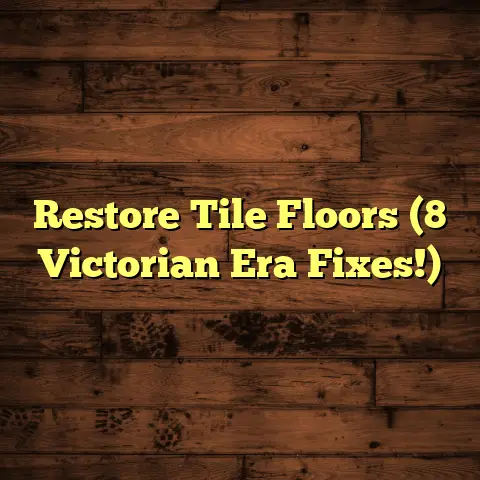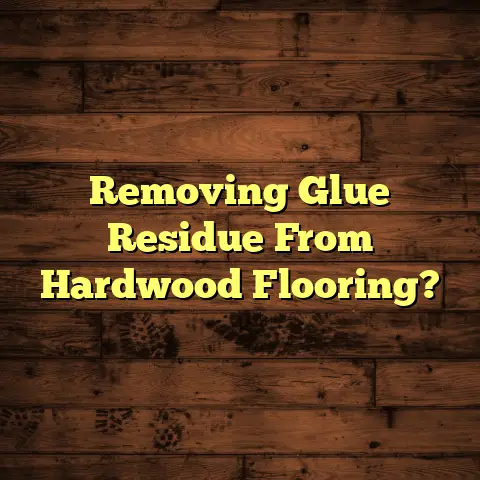Laminate Flooring: Pros & Cons. Right Choice? (3 Top Flaws!)
Choosing the right flooring is HUGE. It sets the stage for everything else. I’ve watched folks agonize over hardwood, tile, carpet, and… laminate.
I remember Sarah, who wanted a beautiful, wood-look floor in her living room but was on a tight budget. Then there’s Mark, who needed something super durable for his rambunctious kids and dogs. Both ended up seriously considering laminate.
Laminate flooring? It’s popular, budget-friendly, and comes in a zillion styles. But is it really the right choice for you? Let’s dive in and find out, and I will also tell you three top flaws!
Section 1: Understanding Laminate Flooring
So, what is laminate flooring, exactly? Basically, it’s a multi-layered synthetic flooring product fused together through a lamination process. Think of it like a high-tech sandwich. Here’s a breakdown:
-
Wear Layer: This is the top layer, a clear, protective coating that resists scratches, stains, and fading.
-
Design Layer: This is where the magic happens. It’s a high-resolution photographic image that mimics wood, stone, tile, or whatever your heart desires.
-
Core Layer: This is the main body of the laminate, usually made of high-density fiberboard (HDF) or medium-density fiberboard (MDF). This layer provides stability and impact resistance.
-
Backing Layer: This bottom layer provides moisture resistance and helps balance the plank, preventing warping.
Laminate’s been around for a while, evolving from a basic alternative to a pretty sophisticated flooring option. It started gaining traction in the late 20th century as a cheaper alternative to hardwood. Over the years, manufacturing processes have improved dramatically, resulting in more realistic designs and better durability.
The manufacturing process is pretty cool. The design layer is printed with incredibly detailed images, and then everything is fused together under high heat and pressure. This process creates a durable, wear-resistant surface that looks surprisingly like the real deal.
Section 2: The Pros of Laminate Flooring
Alright, let’s talk about why so many people choose laminate.
1. Affordability
This is a big one. Laminate is generally much more affordable than hardwood, tile, or stone. I’m talking sometimes 50-70% cheaper!
According to HomeAdvisor, laminate flooring installation costs range from $4 to $11 per square foot, including materials and labor. Hardwood, on the other hand, can easily cost $8 to $25 per square foot.
Think about it: That’s a significant difference, especially if you’re flooring a large area. You can get a beautiful, stylish floor without breaking the bank.
2. Aesthetic Versatility
Seriously, the options are endless. You can find laminate that looks like almost any type of wood (oak, maple, hickory, you name it), as well as stone, tile, and even concrete.
Want a rustic, farmhouse vibe? There’s laminate for that. Modern and sleek? Yep, got that too. Laminate can complement just about any interior style.
I’ve seen homeowners use light-colored laminate to brighten up a dark room, and dark, rich laminate to create a cozy, sophisticated feel. The design possibilities are truly limitless.
3. Durability
Don’t let the lower price fool you. Laminate is surprisingly durable. That wear layer I mentioned earlier? It’s designed to withstand scratches, dents, and fading.
This makes laminate a great choice for high-traffic areas like hallways, living rooms, and even kitchens (with proper care, of course). It’s also a good option for homes with pets or kids who tend to be a little… rough on the floors.
I’ve seen laminate hold up remarkably well in homes with big dogs who love to run and play. Just make sure to choose a thicker laminate with a good wear layer rating (AC rating) for maximum durability. The AC rating measures the abrasion resistance, with AC1 being for light residential use and AC5 being for heavy commercial use. For a busy home, you’ll want at least an AC3 rating.
4. Easy Installation
This is another huge advantage. Most laminate flooring uses a click-lock installation system, which means the planks simply snap together. No nails, no glue, no messy adhesives.
This makes it a perfect DIY project. I’ve seen plenty of homeowners successfully install laminate themselves, saving a ton of money on labor costs.
Now, I’m not saying it’s completely effortless. You’ll still need to measure carefully, cut the planks to fit, and make sure the subfloor is level. But overall, it’s a pretty straightforward process.
5. Low Maintenance
Cleaning laminate is a breeze. Just sweep or vacuum regularly to remove dirt and debris, and occasionally mop with a damp cloth or a laminate floor cleaner.
No waxing, polishing, or special treatments required. Compared to hardwood, which needs regular refinishing, or tile, which can require grout cleaning, laminate is super low-maintenance.
I always tell people to avoid using excessive water when cleaning laminate, as moisture can seep into the seams and cause damage. A damp mop is all you need.
Section 3: The Cons of Laminate Flooring
Okay, so laminate sounds pretty great, right? But it’s not perfect. Let’s talk about the downsides.
1. Limited Repair Options
This is a big one. If a laminate plank gets damaged – say, a deep scratch or a chip – it can be difficult to repair. Unlike hardwood, which can be sanded and refinished, laminate can’t be easily fixed.
In most cases, you’ll need to replace the entire plank. And that can be tricky, especially if you don’t have any extra planks on hand. Plus, even if you do find a matching plank, it might not blend in perfectly with the rest of the floor due to slight variations in color or wear.
I’ve seen homeowners try to use repair kits to fill in scratches, but the results are often less than ideal. The repair compound might not match the color perfectly, or it might not hold up over time.
2. Moisture Sensitivity
Laminate and water? Not a good mix. While some laminate is water-resistant, it’s generally not waterproof. If water seeps into the seams between the planks, it can cause the core layer to swell and warp.
This is especially problematic in kitchens, bathrooms, and basements, where moisture is more likely to be present. A leaky dishwasher, a spilled glass of water, or even just high humidity can cause damage.
Proper installation is crucial to mitigate moisture risks. Make sure to use a moisture barrier underlayment and seal the edges of the floor with caulk.
3. Sound and Feel
Let’s be honest: Laminate doesn’t feel exactly like real wood or tile. It can sometimes feel a little… hollow underfoot. And it can be a bit noisy to walk on, especially if you’re wearing hard-soled shoes.
Some people find the sound and feel of laminate to be less authentic and less luxurious than natural materials. It might not provide the same warmth or acoustic benefits as hardwood or carpet.
However, there are ways to improve the sound and feel of laminate. Using a thicker underlayment can help cushion the floor and absorb sound. Also, some newer laminate products have textured surfaces that mimic the feel of real wood.
Section 4: The Right Choice?
So, is laminate flooring the right choice for you? It depends. There’s no one-size-fits-all answer.
Think about your budget. Can you afford hardwood or tile? If not, laminate might be a great alternative.
Consider your lifestyle. Do you have kids or pets? Do you need a super durable, easy-to-clean floor? Laminate might be a good fit.
What’s your aesthetic preference? Do you want the look of real wood or stone? Laminate can deliver that, but it might not have the same authenticity as the real thing.
And what are your long-term plans for the home? Are you planning to sell in a few years? If so, hardwood might be a better investment, as it can increase resale value.
I talked to a homeowner named Maria who installed laminate in her basement. She said, “I was hesitant at first, but I’m so glad I did it. It looks great, it’s easy to clean, and it was so much more affordable than other options. Plus, I installed it myself, which saved me a ton of money.”
Another homeowner, David, said, “I regret not spending the extra money on hardwood. The laminate looks okay, but it doesn’t have the same warmth and character as real wood. And it’s a little noisy to walk on.”
Section 5: The Three Top Flaws of Laminate Flooring
Okay, let’s zoom in on the three biggest potential problems with laminate. These are the things I see causing headaches for homeowners down the road.
1. Wear and Tear Over Time
Even the most durable laminate will show signs of wear and tear eventually. After several years, you might start to see scratches, scuffs, and fading, especially in high-traffic areas.
The wear layer will eventually wear down, exposing the design layer underneath. And once that happens, there’s not much you can do to restore the floor.
Compared to hardwood, which can last for decades with proper care and refinishing, laminate has a shorter lifespan. You might need to replace it after 10-20 years, depending on the quality of the laminate and how well you maintain it.
2. Environmental Concerns
Some laminate flooring contains formaldehyde, a chemical that can be harmful to human health. Formaldehyde is used in the resins that bind the core layer together.
While most laminate flooring sold today meets strict formaldehyde emission standards, it’s still something to be aware of. Look for laminate products that are certified by organizations like the FloorScore program, which ensures that they meet low-VOC (volatile organic compound) emission standards.
Also, consider the sustainability of the materials used to make the laminate. Some laminate is made from recycled wood fibers, which is a more environmentally friendly option.
3. Resale Value
Laminate flooring generally doesn’t add as much value to a home as hardwood or tile. While it can be a selling point, it’s not as highly regarded by potential buyers.
Real estate experts say that buyers often prefer hardwood because it’s seen as a more premium, long-lasting material. Laminate might be perceived as a cheaper, less desirable alternative.
That’s not to say that laminate will hurt your home’s resale value. A well-maintained laminate floor can still look great and appeal to buyers. But if you’re looking to maximize your home’s value, hardwood might be a better investment.
Conclusion
Choosing the right flooring is a big decision. Laminate flooring has a lot to offer: affordability, versatility, durability, and easy installation. But it also has some drawbacks: limited repair options, moisture sensitivity, and potential concerns about sound, feel, wear and tear over time, environmental concerns, and resale value.
Think about your own renovation story. What are your priorities? What’s your budget? What’s your lifestyle?
If you’re looking for a budget-friendly, durable, and stylish flooring option, laminate might be the perfect choice. But if you’re looking for a long-lasting, luxurious, and environmentally friendly option, hardwood or tile might be a better fit.
Whatever you decide, do your research, weigh the pros and cons, and choose the flooring that best aligns with your needs, lifestyle, and aesthetic goals. Good luck with your renovation project!





